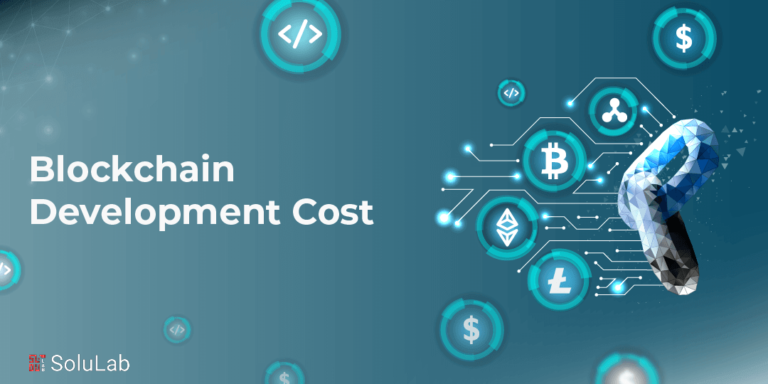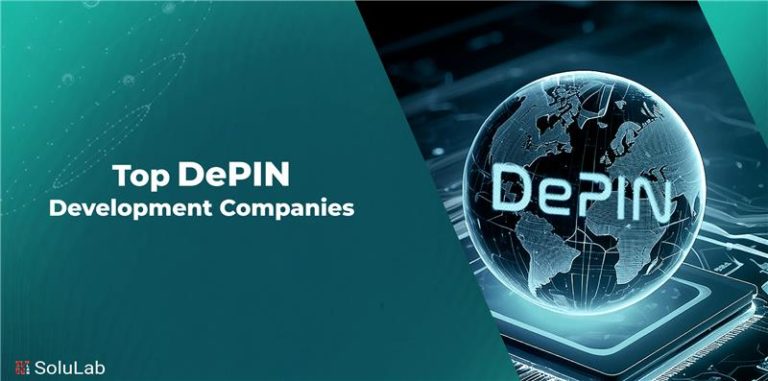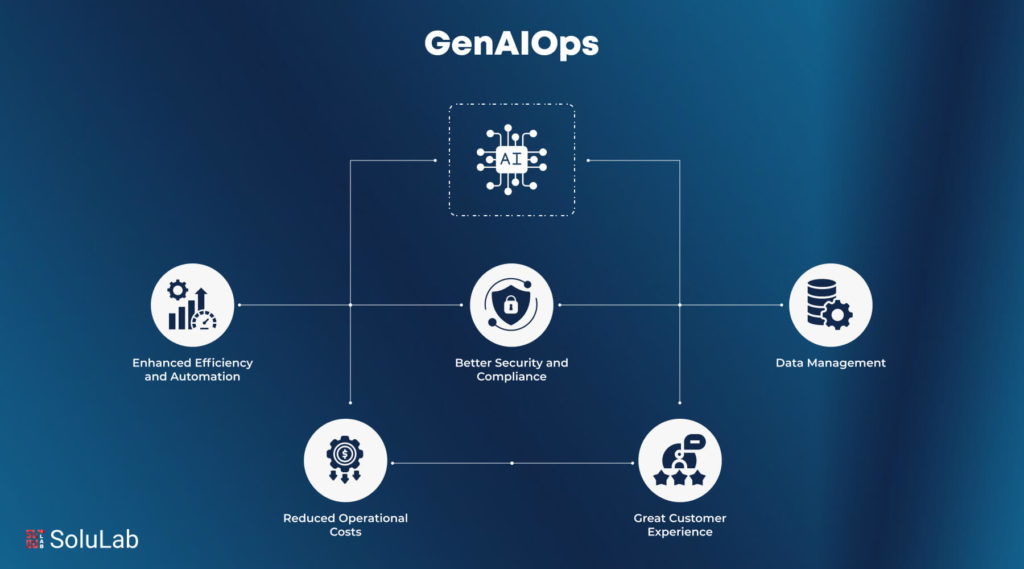
Generative AI is seen as a top emerging technology, with 74% of business leaders predicting it will significantly impact their businesses within the next 12-18 months. This reflects a strong belief in its potential to drive innovation and efficiency across various industries. As organizations increasingly rely on Generative AI to handle difficult problems using natural language commands, effective implementation of these technologies becomes essential. GenAIOps, an acronym for Generative AI Operations, arises as a solution, offering a collection of principles and procedures for developing and implementing Generative AI solutions in an organizational setting. GenAIOps provides a comprehensive method for designing, testing, and deploying Generative AI systems, including data operations (DataOps) and large language model operations (LLMOps), as well as development and operations (DevOps).
In this blog, we will look into the particular issues that organizations encounter when using Generative AI, as well as how GenAIOps tackles them. It focuses on the fundamental components of GenAIOps, its structure, best practices for organizations, obstacles, and the future of GenAIOps in AI.
By the end of this article, you will understand how GenAIOps helps organizations successfully operationalize Generative AI technologies and realize their disruptive potential.
What is GenAIOps?
GenAIOps, or Generative AI Operations, is a collection of strategies and procedures for developing and implementing Generative AI solutions in a corporate setting. It builds on standard MLOps frameworks to handle the specific issues brought by AI technology. The way that GenAIOps handles and works with an overarching model that covers the whole AI lifecycle is what makes it unique. This involves pretraining the foundation model, aligning it by supervised fine-tuning, tailoring it to a particular use case, pre/post-processing logic, and linking it with other foundation models, guardrails, and APIs.
When it comes to all generative AI workloads, covering language, picture, and multimodal jobs, GenAIOps include MLOps, DevOps, DataOps, and ModelOps. It entails reconsidering generative AI’s data curation, model training, customization, assessment, optimization, deployment, and risk management.
By 2025, global spending on generative AI is expected to reach $110 billion, highlighting the rapid investment and growing importance of this technology in the business landscape. Guardrails, prompt management, agent/chain management, embedding management, artificial data management, and guardrails are some of the new, emergent GenAIOps features. In addition to defining intricate multi-step application logic, managing prompts, intercepting adversarial or invalid inputs, and representing data samples as dense multi-dimensional embedding vectors, these features expand data management.
In general, GenAIOps encompasses more than simply platform capabilities and tools to support AI development. Techniques for establishing objectives and KPIs, assembling teams, tracking advancement, and consistently enhancing operational procedures are also covered.
Essential Aspects of GenAIOps
Apart from the aforementioned features, GenAIOps facilitates the deployment and oversight of AI models and encourages collaboration within departments to maximize AI performance.
- Deployment and Monitoring: GenAIOps brings additional features designed to address the particular difficulties associated with generative AI model deployment, monitoring, and upkeep in real-world settings. These features guarantee the efficient and dependable operation of generative AI models, including large language models (LLMs), inside the production infrastructure. GenAIOps ensures optimal performance and reliability by facilitating the smooth integration of generative AI into organizational processes through the provision of improved deployment and monitoring tools.
- Collaboration: Similar to MLOps, cross-functional cooperation across different teams within an organization is necessary for the effective deployment of GenAIOps. Close collaboration between IT operations teams, computer scientists, and data scientists is part of this. Effective generative AI model development, deployment, and maintenance need teamwork. In order to guarantee that generative AI models are implemented, efficiently monitored, and maintained to provide the most possible value to the company, GenAIOps promotes communication and cooperation between these important stakeholders.
How Does GenAIOps Help Your Business?
Generative AI operations, or GenAIOps, have several benefits for businesses wishing to use generative AI solutions efficiently.
- Faster Time-to-Market: Shorter AI product iteration cycles result from automating and speeding up end-to-end generative AI workflows, which increases the organization’s flexibility and ability to respond to new problems.
- Risk Reduction: While foundation models have the potential to revolutionize a number of sectors, there is a chance that they will accentuate biases or mistakes that are already present in their training data. GenAIOps guarantees a proactive approach to reducing these flaws and taking on moral dilemmas head-on.
- Collaboration Made Easier: GenAIOps makes it easier to transfer knowledge and artifacts between projects and allows for seamless handoffs between teams, including data engineering, research, and product engineering inside a single project. Standardization, cooperative tooling, and strict operational rigor are necessary to keep many things in sync.
- Lean Operations: GenAIOps offers specific solutions for each stage of the AI lifecycle, helps optimize workloads, and automates repetitive jobs. Higher productivity and a decreased total cost of ownership (TCO) are the outcomes of this.
- Reproducibility: GenAIOps ensures that a successful experiment run may be repeated on demand by keeping track of code, data, models, and configurations. This becomes particularly important for regulated businesses, as being able to repeat results is now a need rather than a bonus.
- Improving User Experiences: GenAIOps helps AI applications run as efficiently as possible in production. Companies can provide better user experiences via chatbots, virtual assistants, content producers, and data analytic instruments.
- Opening Up New Income Sources: Businesses may expand into new markets, create new revenue streams, and diversify their product offerings by utilizing customized applications of generative AI made possible by GenAIOps.
The use of GenAIOps in enterprises yields revolutionary advantages for businesses, augmenting efficiency, inventiveness, and moral principles while permitting the actualization of generative AI technology’s whole potential.
Benefits of GenAIOps
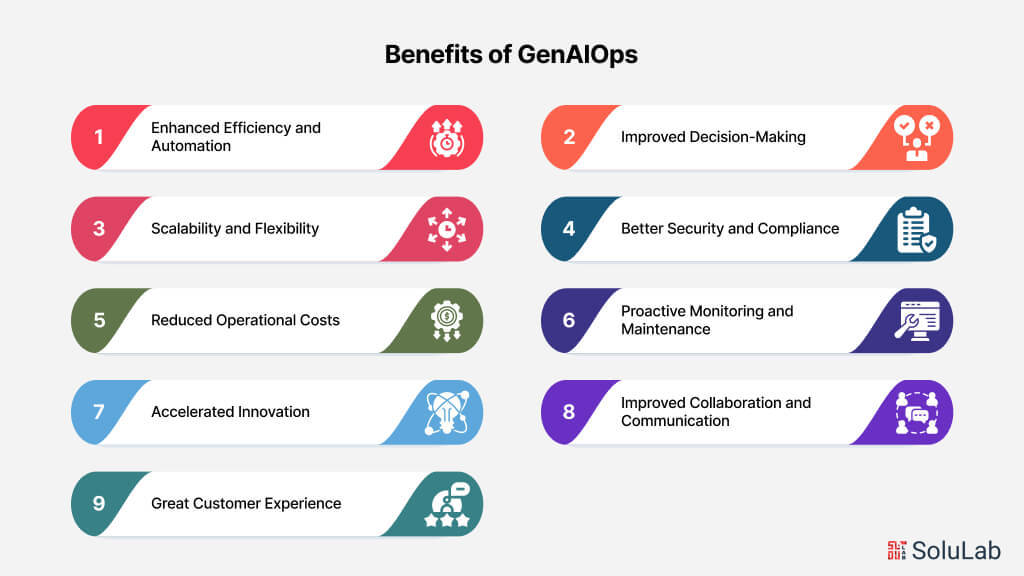
Generative AI Ops services bring significant advantages to IT operations by combining generative AI with traditional DevOps practices. These benefits streamline processes, enhance efficiency, and provide actionable insights, ultimately driving business success.
1. Enhanced Efficiency and Automation: GenAIOps automates repetitive and time-consuming tasks, such as code generation, testing, and deployment. This reduces manual effort, minimizes errors, and accelerates development cycles, allowing teams to focus on more strategic activities.
2. Improved Decision-Making: By analyzing vast amounts of data in real time, GenAIOps provides actionable insights that help in making informed decisions. This leads to better resource allocation, optimized workflows, and proactive issue resolution, enhancing overall operational effectiveness.
3. Scalability and Flexibility: GenAIOps can easily scale to meet the demands of growing businesses. It provides the flexibility to adapt to changing requirements and integrates seamlessly with existing tools and systems, ensuring continuous improvement and innovation.
4. Better Security and Compliance: GenAIOps incorporates advanced AI-driven security measures, such as anomaly detection and threat intelligence, to proactively identify and mitigate security risks. This helps in maintaining robust security postures and ensuring compliance with regulatory requirements.
5. Reduced Operational Costs: By automating tasks and improving operational efficiencies, GenAIOps significantly reduces the costs associated with manual labor and resource management. This allows organizations to allocate their budgets more effectively and invest in strategic growth initiatives.
6. Proactive Monitoring and Maintenance: GenAIOps enables continuous monitoring and predictive maintenance, reducing downtime and improving system reliability. AI algorithms can predict potential issues before they become critical, allowing for timely interventions and minimizing disruptions.
7. Accelerated Innovation: With GenAIOps handling routine tasks, development teams can focus on innovation and creative problem-solving. This fosters a culture of continuous improvement and rapid development of new features and products, driving competitive advantage.
8. Improved Collaboration and Communication: GenAIOps facilitates better collaboration between development and operations teams by providing a unified platform for managing workflows and sharing insights. This enhances communication, reduces silos, and ensures that everyone is aligned toward common goals.
Read Our Blog: Generative AI for Customer Service
9. Great Customer Experience: By improving operational efficiency, reducing downtime, and accelerating innovation, GenAIOps contributes to a better overall customer experience. Customers benefit from faster service delivery, improved reliability, and more innovative products and services.
Best Practices for Implementing GenAIOps
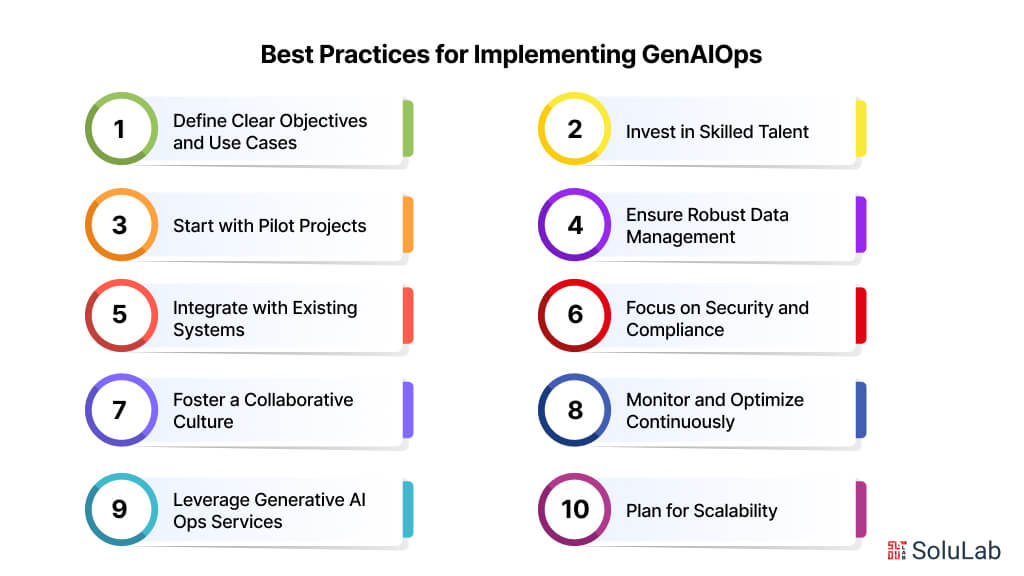
Implementing GenAIOps for enterprises requires a strategic approach that maximizes its benefits while addressing potential challenges. Here are some best practices to consider:
1. Define Clear Objectives and Use Cases
Before implementing GenAIOps, enterprises should identify specific objectives and use cases. This helps in aligning GenAIOps initiatives with business goals, ensuring that the deployment addresses real needs and delivers tangible value.
2. Invest in Skilled Talent
One of the major barriers to GenAIOps implementation is the lack of skilled talent. Investing in training and hiring professionals with expertise in AI, machine learning, and DevOps is crucial for the successful deployment and management of GenAIOps services.
3. Start with Pilot Projects
Begin with pilot projects to test GenAIOps in a controlled environment. This allows enterprises to identify potential issues, refine processes, and demonstrate value before scaling up. Successful pilots can provide valuable insights and build confidence across the organization.
4. Ensure Robust Data Management
GenAIOps relies heavily on data. Implement strong data management practices to ensure data quality, security, and governance. This includes establishing protocols for data collection, storage, and access, as well as ensuring compliance with relevant regulations.
5. Integrate with Existing Systems
For seamless implementation, ensure that GenAIOps solutions integrate well with existing IT infrastructure and tools. This facilitates smooth transitions, reduces disruptions, and leverages current investments in technology.
6. Focus on Security and Compliance
As GenAIOps involves handling sensitive data and critical operations, prioritize security and compliance. Implement advanced security measures, such as encryption, access controls, and continuous monitoring, to protect against threats and ensure regulatory compliance.
Read Blog: An Ultimate Guide to Generative AI for Compliance
7. Foster a Collaborative Culture
Encourage collaboration between development, operations, and AI teams. A unified approach helps in leveraging diverse expertise, fostering innovation, and ensuring that all stakeholders are aligned toward common goals.
8. Monitor and Optimize Continuously
Continuous monitoring and optimization are key to maximizing the benefits of GenAIOps. Regularly assess performance, identify bottlenecks, and make necessary adjustments to improve efficiency and effectiveness.
9. Leverage Generative AI Ops Services
Consider leveraging external generative AI Ops services for specialized tasks or to augment internal capabilities. These services can provide additional expertise, tools, and resources, helping enterprises achieve their GenAIOps goals more effectively.
10. Plan for Scalability
Ensure that your GenAIOps implementation is scalable. As the organization grows and evolves, the GenAIOps framework should be able to scale accordingly, supporting increased workloads and new use cases without compromising performance.
By following these best practices, enterprises can effectively implement GenAIOps, driving operational excellence and achieving their strategic objectives.
MLOps vs. GenAIOps
MLOps (Machine Learning Operations) and GenAIOps (Generative AI Operations) are two approaches within AI and machine learning technology, each focusing on different aspects of AI deployment and operations. While both aim to streamline AI workflows and enhance operational efficiency, they have distinct focuses and methodologies.
A. Focus and Application
- MLOps: Primarily focuses on the operationalization of machine learning models. It involves the end-to-end lifecycle management of ML models, from development and training to deployment, monitoring, and maintenance. MLOps is essential for ensuring that machine learning models are reliable, scalable, and integrated seamlessly into production environments.
- GenAIOps: Specifically targets generative AI applications, which involve creating new content, such as text, images, music, or code, using AI models. GenAIOps encompasses developing, deploying, and optimizing generative AI models, focusing on ensuring these models generate high-quality and relevant outputs efficiently.
B. Core Processes
- MLOps: Emphasizes the automation of ML workflows, including data preprocessing, model training, versioning, validation, deployment, and monitoring. It integrates DevOps practices with machine learning to streamline model management and operational processes.
- GenAIOps: Involves processes tailored to generative AI, such as training models on extensive datasets to generate new content, fine-tuning models to improve output quality, and deploying these models in applications where creative or generative capabilities are required. It also includes continuous learning and improvement of generative models based on user feedback and new data.
C. Tools and Technologies
- MLOps: Utilizes tools like Kubernetes for container orchestration, MLflow for tracking and managing ML experiments, and TensorFlow Extended (TFX) for building production ML pipelines. These tools facilitate the deployment and monitoring of ML models at scale.
- GenAIOps: Employs specialized tools and frameworks for generative AI, such as OpenAI’s GPT-3 for text generation, DALL-E for image generation, and custom neural network architectures designed for specific generative tasks. These tools are optimized for handling the unique requirements of generative models.
D. Challenges
- MLOps: Faces challenges related to model drift, reproducibility, scalability, and integration with existing IT infrastructure. Ensuring that models remain accurate and relevant over time requires continuous monitoring and retraining.
- GenAIOps: Encounters challenges in ensuring the quality and relevance of generated content, handling biases in generative models, and managing the computational resources required for training large generative models. Balancing creativity and control in generative outputs is also a key challenge.
E. Business Impact
- MLOps: Enhances business operations by enabling the reliable deployment of predictive models that can improve decision-making, automate processes, and drive efficiencies across various domains, such as finance, healthcare, and retail.
- GenAIOps: Drives innovation and creativity in businesses by enabling the creation of new content, personalized marketing, and customer engagement strategies. It opens up new possibilities for product development, content creation, and user experiences.
While MLOps and GenAIOps share common goals of optimizing AI operations, they cater to different aspects of AI application—predictive modeling for MLOps and content generation for GenAIOps. Understanding their unique processes, tools, and challenges helps organizations leverage each approach effectively to meet their specific AI needs.
The Future of GenAIOps
The future of GenAIOps (Generative AI Operations) is set to transform the landscape of enterprise AI, driving significant advancements in operational efficiency, creativity, and strategic decision-making. Here are some key trends and projections for the future of GenAIOps:
- Increased Integration with Enterprise Systems: As generative AI becomes more essential, businesses will push for tighter integration of GenAIOps with existing enterprise systems and workflows. This seamless integration will enhance productivity and ensure that generative AI outputs are directly aligned with business goals, enabling smoother operations and quicker adoption across various functions.
- Enhanced Customization and Personalization: Generative AI will continue to evolve in producing highly customized and personalized outputs. From tailored marketing content to individualized product recommendations, GenAIOps will enable enterprises to meet specific customer needs more effectively, enhancing customer satisfaction and loyalty.
- Advanced AI-driven Automation: The automation capabilities of GenAIOps will expand, reducing the need for human intervention in routine and complex tasks. This will allow enterprises to streamline operations, minimize errors, and allocate resources more strategically. Automation in GenAI will extend beyond traditional tasks to include creative processes, such as content creation and product design.
- Ethical AI and Bias Mitigation: As the use of generative AI grows, so will the focus on ethical AI practices and bias mitigation. Enterprises will implement more robust frameworks to ensure fairness, transparency, and accountability in AI-generated outputs. This will involve ongoing monitoring and adjustments to AI models to prevent biased or unethical results.
- Scalability and Performance Optimization: Future advancements in GenAIOps will emphasize scalability and performance optimization. Enterprises will invest in more powerful computing infrastructure and more efficient algorithms to handle the increasing demands of generative AI applications. This will support the deployment of large-scale AI models that can operate efficiently and effectively across diverse environments.
- Real-time Data Integration and Continuous Learning: GenAIOps will increasingly leverage real-time data integration and continuous learning to keep AI models up-to-date and relevant. By constantly learning from new data, generative AI systems will improve their accuracy and adaptability, allowing enterprises to respond swiftly to changing market conditions and emerging trends.
- Cross-Industry Applications: The applications of GenAIOps will expand across various industries beyond traditional tech sectors. Industries such as healthcare, finance, retail, and entertainment will harness generative AI for tasks ranging from drug discovery and financial forecasting to personalized shopping experiences and content generation. This cross-industry adoption will unlock new opportunities and drive innovation.
- Collaboration Between AI and Human Creativity: The future of GenAIOps will see increased collaboration between AI and human creativity. AI will augment human capabilities by providing tools that enhance creative processes, such as design, writing, and art. This synergy will lead to the creation of novel and innovative solutions that neither AI nor humans could achieve alone.
By embracing these trends, enterprises can harness the full potential of GenAIOps to drive innovation, efficiency, and competitive advantage in an increasingly AI-driven world. The future of GenAIOps is bright, promising transformative impacts across all sectors.
Conclusion
In summary, GenAIOps is transforming enterprise operations by enhancing efficiency, enabling advanced automation, and driving innovation. By leveraging the power of generative AI, businesses can automate routine tasks, improve decision-making, and create personalized experiences for their customers. As the adoption of GenAIOps continues to grow, it promises to unlock new levels of productivity and creativity, paving the way for a future where AI-driven operations become the norm across various industries.
However, the implementation of GenAIOps also presents challenges, such as the need for skilled talent, ensuring data quality and security, and integrating AI systems with existing infrastructure. SoluLab, as a leading Generative AI development company, is well-equipped to address these challenges. Our expertise in AI and machine learning, combined with a comprehensive suite of services, ensures seamless integration, robust data management, and continuous optimization of GenAIOps solutions. Contact us today to start your GenAIOps journey!
FAQs
1. What is GenAIOps?
GenAIOps, short for Generative AI Operations, represents the convergence of generative AI techniques with IT operations management. It harnesses the power of artificial intelligence to automate and optimize various facets of IT operations, including monitoring, troubleshooting, and incident response. Unlike traditional methods that rely heavily on predefined rules, GenAIOps utilizes machine learning models to learn from data and adapt dynamically to changing IT environments. This enables organizations to achieve higher levels of efficiency, scalability, and proactive management in their IT operations.
2. What are the key benefits of implementing GenAIOps?
Implementing GenAIOps offers several compelling advantages for organizations. It enables automation of repetitive tasks, reducing manual effort and operational costs while improving overall efficiency. By leveraging AI-driven insights, GenAIOps facilitates proactive monitoring and predictive maintenance, helping organizations identify and resolve issues before they impact business operations. Additionally, GenAIOps supports scalability, allowing IT teams to manage growing complexities and demands effectively through intelligent automation and resource optimization.
3. How does GenAIOps differ from traditional IT operations management?
GenAIOps distinguishes itself from traditional IT operations management through its reliance on generative AI capabilities. Unlike traditional methods that operate on fixed rules and patterns, GenAIOps employs machine learning algorithms to analyze data, detect patterns, and make informed decisions in real time. This adaptive approach enables GenAIOps to handle the dynamic and complex nature of modern IT environments more effectively, leading to improved responsiveness, agility, and proactive problem-solving capabilities.
4. What are some use cases of GenAIOps in modern IT environments?
GenAIOps finds application across various critical areas within modern IT operations. It is instrumental in predictive maintenance, where AI models predict and prevent system failures by analyzing historical data and identifying anomalies. In cybersecurity, GenAIOps enhances threat detection and response through AI-powered analytics, enabling organizations to mitigate risks proactively. Additionally, GenAIOps supports automated remediation of IT issues, performance optimization through AI-driven insights, and seamless integration into DevOps processes, enhancing overall operational efficiency and reliability.
5. How can organizations integrate GenAIOps into their existing IT infrastructure?
Integrating GenAIOps into existing IT infrastructure involves a structured approach. Organizations begin by assessing their current IT operations and identifying specific areas where AI can deliver tangible benefits. This is followed by data preparation, where relevant datasets are cleaned and curated for AI model training. Next, organizations select appropriate generative AI models based on their operational needs and deploy them into their IT systems. Continuous monitoring and optimization are essential to ensure that AI models perform effectively and adapt to evolving operational requirements, ultimately enhancing organizational productivity and resilience.





